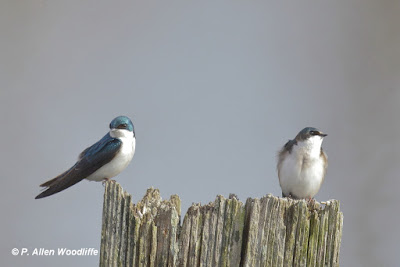Not long ago I went up towards Mitchell's Bay. From Angler Line, I looked northwards and saw some extensive plumes of smoke. When the marshes and prairies of Walpole Island are burning, it is definitely a sign of spring.
 |
| From Angler Line |
 |
| From Mitchell's Bay |
 |
| Zoomed in from Mitchell's Bay |
Earlier in the week I was at Rondeau. There is a slow but steady trickle of birds arriving. Along the South Point Trail I came across this Eastern Phoebe. It must have just arrived, as it was resting, with its eyes closed. It was right along the trail, just below my eye level. I could have reached out and touched it, but instead backed up so I could focus the camera.
After a few moments, it seemed to wake up, yawned and started moving around. These photos have been hardly cropped at all.
The sunny day meant that frogs were making use of the warmth. Wood Frogs, Spring Peepers and Leopard Frogs were all in chorus.
 |
| Wood Frog |
 |
| Leopard Frog |
Purple Martins are back. This one was on a wire and against a white sky, making photography quite challenging.
I also had a Bank Swallow in flight, and today I had a couple of Barn Swallows. Hopefully the weather doesn't turn too cold for too long to reduce the insect population these swallows depend on.
Horned Grebes are fairly plentiful, and are in all different stages of plumage change right now.
Canada Geese are well into the nesting cycle
 |
| Trying to look inconspicuous on the nest |
Today I spent some time at Rondeau. The highlight of my hike along the South Point Trail was a Northern Mockingbird. It was right at the southernmost part of the trail. I heard some fairly loud chirpy/chipping notes that I couldn't quite place, and the bird was low in a dense patch of rose bushes, making it impossible to see. It eventually popped up and I could immediately tell it was a mockingbird, but before I got the camera focused on it, it moved farther back and out of sight. It is always nice to see one of these birds, but this wasn't even my first of the year. I had one on Jan 1 on the St. Clair NWA Christmas Bird Count.
I had at least 5 Red Admiral butterflies along the trail, but they were quite active and on the rare occasion one landed, they closed their wings up. Since I only had my 500mm lens and 1.4X converter on, it wasn't really good for photographing butterflies, and so I didn't get any useful shots.
Northern Flickers are fairly common.
Pileated Woodpeckers are quite vocal.
Hermit Thrushes are widely scattered.
I got my first Brown Thrasher of the year.
Rusty Blackbirds are declining. I saw 4 in a shrubby slough along Gardiner Ave. They used to occur in quite large flocks on their way to their boreal forest nesting grounds, but the populations have dropped drastically as they have been persecuted in their southern hemisphere wintering grounds. They are now considered a Special Concern species as listed under Ontario's Endangered Species Act. Hopefully they won't get to Threatened or Endangered.
As for birds in the park, it is no secret that the best news of the week is that the White-winged Dove has returned. I was on my way out to the park on Tuesday, April 9, when I got a message that Mel, the owner of the cottage where the bird has spent much of its time in the past few years, had seen the bird that morning for the first time this year. He got the word out to several birders....thanks, Mel! It typically shows up sometime between about April 7-10, depending on the weather. As I was heading to the park anyway, I stopped at Mel's place first and heard the bird. Mel was there and pointed it out, and I got several photos like this next one.
The big question is: will its mate that showed up late last year arrive this season, and early enough so that their attempts at nesting will be successful? Since it is a fairly long-lived species, maybe there is hope for a small colony to become established at Rondeau yet!
Upon leaving the park today, I had already decided to check out the flooded fields at the Keith McLean Conservation Lands. The high water resulting in flooded fields is certainly beneficial for various water birds as of late. The numbers of ducks are slowly declining, but shorebirds are showing up nicely. I had 7 species of shorebirds there on this visit, some of which were distantly visible from the road. I decided to park in the property's parking lot and walk towards the creek system, and follow it around to look at the larger section of the flooded field. I came across 27 Pectoral Sandpipers, 4 Greater Yellowlegs, 3 Lesser Yellowlegs, half a dozen Dunlin, several Killdeer, a Wilson's Snipe that flew over, and what I am sure is a Black-bellied Plover. Not a bad shorebird diversity for this date.
 |
| Dunlin |
 |
| Pectoral Sandpiper |
 | |||||
| Greater Yellowlegs |
 |
| Two Lesser Yellowlegs and one Greater |
 | ||
| Black-bellied Plover |
I also stopped at Shrewsbury before returning home, as I wanted to check on a small heronry in a willow tree about half a kilometre NE of the main dock and boat launch.
There is now only a single Great Blue Heron nest in what is left of this gradually deteriorating willow tree.
April showers are being forecast for several days of this next week. I guess that is good news for the May flowers, and maybe even an indication of southwesterly weather systems that will bring all those migrants winging it back to Ontario. Stay tuned!

















No comments:
Post a Comment